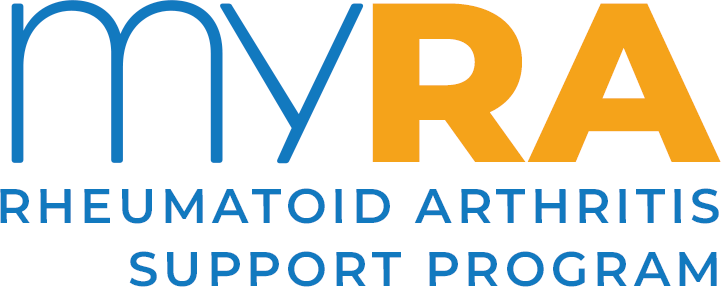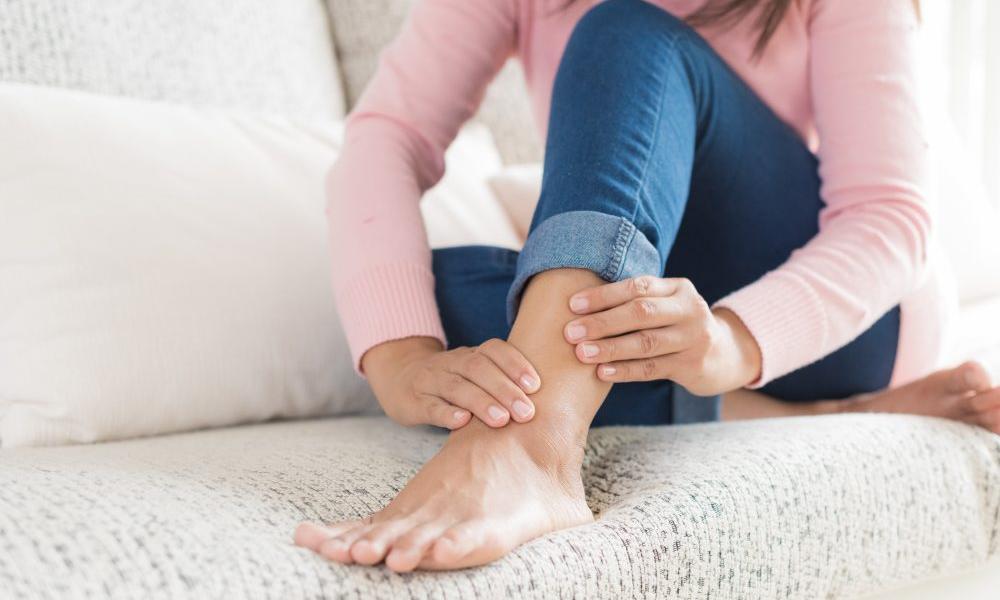
What is a joint and how does it work?
A joint is where two or more bones meet and is made up of a number of different parts that all work together so that we can bend, stretch, twist and turn easily – but within certain limits. Most of our joints are designed to allow bones to move only in certain directions.
The ends of your bones are covered in a thin layer of cartilage. This cushions the joint and helps to spread the load evenly when you put pressure on it. Its smooth, slippery surface allows your bones to move freely, without friction.
Surrounding the joint is a tough, fibrous sleeve called the capsule, which stops your bones from moving too much. The inner surface of the joint capsule (the synovium) produces a thick fluid that nourishes the cartilage and lubricates the joint.
Within or just outside the joint capsule are ligaments that help to hold the joint together and prevent it dislocating. The bursa helps to reduce friction in the joint.
At either side of the joint, your muscles are attached to the bones by tendons. As your muscles contract, they pull on the bones to make the joint bend, straighten or rotate.
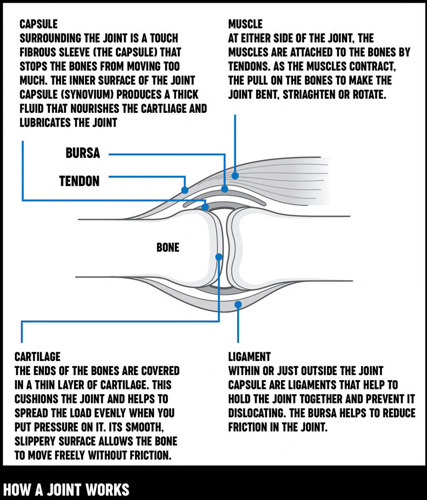
Joint damage in rheumatoid arthritis (RA)
If you have RA your ligaments may become stretched and slack because of repeated swelling of the joint. These changes may start quite early in the condition.
The way you use your joints can contribute to the development of deformities. Your hands are particularly at risk because of their many small joints in constant use. These deformities can cause problems with activities that need a good grip. Common deformities in people with RA include:
- your wrist or knuckles slipping downwards so that they partially dislocate (subluxation)
- your fingers bending over towards your little finger (ulnar drift)
- your finger or thumb joints buckling (swan neck, boutonniere finger or z-shaped thumb deformities).
About half of all people who have RA will have developed some hand deformities after about five years, so have a look at your own hands carefully and see if any of them have started to happen.
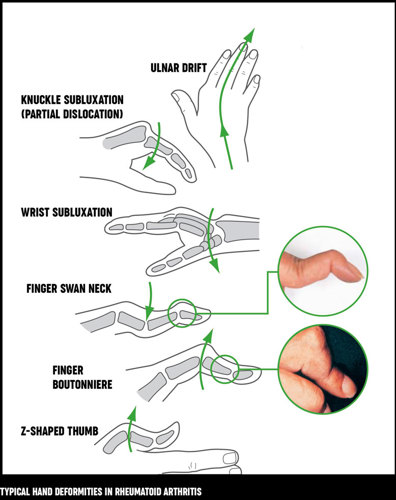
Using joint protection techniques
The way you use your joints can increase the aches, pain and strain that you feel and, over time, it can increase any deformity. This is why you should take notice of pain. Listen to your body – if you’re still having pain an hour after an activity, try taking more short breaks next time.
Many people will give up an activity if it hurts (for example gardening), but it’s better to do a little at a time, with plenty of rests, rather than give up something you enjoy.
Try using some of the techniques below to help you to protect your joints.
1. Use splints and supports
Wearing splints can often help to ease the strain or pain in your joints. There are two types of hand and wrist splints.
- Working splints (elastic wrist and thumb splints) provide more flexible support to help reduce pain while you’re working.
- Resting splints consist of a custom-made cradle with straps to hold it in place. These can help if you have pain at night which affects your sleep or if you need to rest your hands for a short time during the day.
Some people find that compression gloves are also helpful in reducing pain and swelling and are easier to wear. These can be worn day or night, when working or resting.
A hand therapist or physiotherapist can explore the options with you.
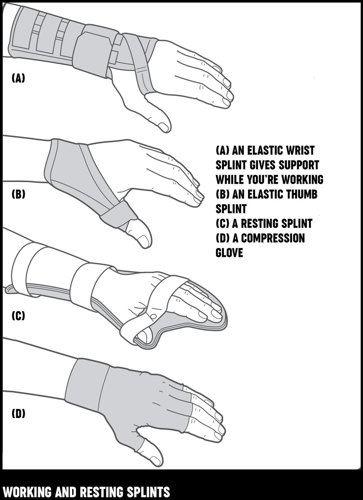
2. Use stronger joints
Try the following tips:
- Use your hip or shoulder instead of your hand to close a drawer or door.
- Hug larger objects close to your body as you carry them.
- Carry bags on your forearms.
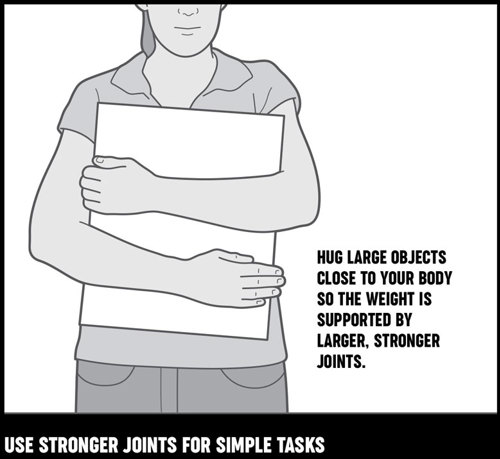
3. Spread the load
Spread the load over several joints when you're carrying items by using these techniques:
- Use two hands.
- Keep as much of your hand as possible in contact with the object.
- Avoid gripping with your thumbs.
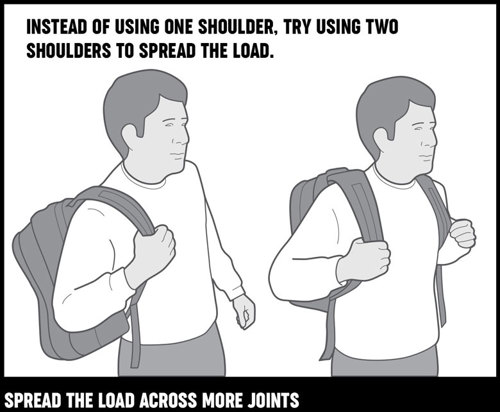
5. Use less effort
You might want to try the following:
- Use labour-saving gadgets, which can be found at many department stores or supermarkets. Examples include vegetable peelers with chunky non-slip handles and battery/electric-powered can openers, but many others are available. An occupational therapist can help you find these.
- Reduce the weight of what you lift.
- If you can’t reduce the weight, shift, not lift – use a trolley or wheelbarrow, or try sliding objects across the work surface.
6. Avoid gripping things tightly
You tend to use a tight grip when you do things like writing, knitting or using a screwdriver, but this puts a lot of strain on your knuckles and thumb joints. To reduce the strain:
- take frequent breaks to rest your hands briefly
- reduce the length of time you spend doing these activities and try to relax your grip
- use padding to make the grip on things such as your pen, knife, toothbrush or spanner larger.
What can I do to improve my grip?
Many people with hand arthritis find their grip weakens and their hands become stiffer, which can be very frustrating. Regular hand exercises will improve your grip. Do them most days for short periods a couple of times a day. Start slowly and build up the amount of exercise you do over several weeks. Ask to be referred to an occupational therapist or physiotherapist for extra exercises to suit your particular needs.
7. Use more stable joint positions
Change position from one that puts strain on particular joints to one that spreads your weight evenly over several joints. Try the following tips:
- Sit or stand as close as you can when working at a table or bench – this reduces stretching and bending.
- Keep your weight so it’s supported evenly through both your legs, standing with your hips square and facing forward.
- Use a grip that keeps your wrists straight and your fingers in line with your wrist when carrying things.
- When lifting objects, reduce the strain or pull on your shoulder by keeping your elbow bent and in front of your body. When reaching up, keep your palm facing the ceiling. To lower your arm, bend your elbow, bringing your hand closer to your body.
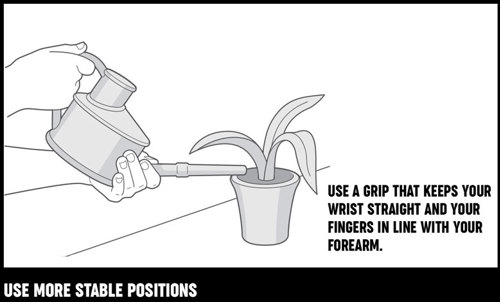
For more tips, practical advice and information on adaptations you can make to your home and workplace, see our information on managing at home.
How can I avoid positions that push my joints towards deformity?
By becoming aware of how you use your hands, you can identify which movements push your joints in the direction of the deformities described earlier. The important things to avoid are:
- lifting heavy objects with your wrists bent downwards
- pushing your fingers over towards your little finger and putting pressure on your thumb
- twisting or over-straightening your fingers.
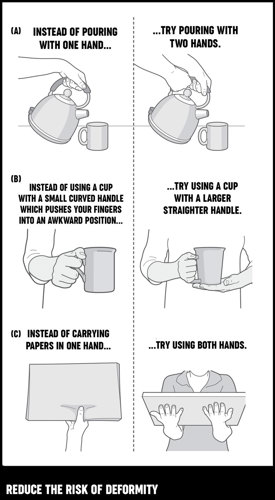
Following all the suggestions in this section would be a lot to change all at once, and changing the habits of a lifetime can be difficult to do.
It’s a good idea to change things bit by bit. You might find it helps to write down the benefit you’ll get from making the changes. You could set yourself a goal each week to change two or three things – start with something that’s causing you most pain and try following the steps:
- Work out another way of doing the task which causes less pulling or pain on your joints.
- Practise the new movements until you get them right and feel comfortable doing them.
- Keep practising until the new movements become automatic.
- If possible get a friend or a family member to remind you if you slip into bad habits.
Avoiding tiredness
Try some of the tips below to help you avoid tiredness.
1. Organise and pace yourself
To help you avoid tiredness, look at how you’re doing things and see if you can organise a job better. Ask yourself the following questions:
- Do you have everything you’ll need to use nearby before you start?
- Can you cut out any part of the job or do it more efficiently?
- Can you sit rather than stand to work?
- Can you slow down a bit?
Store things where you can reach them more easily. Organise your cupboards with the things you use most often at the front and get rid of things you don’t use.
Think also about pacing yourself. The best ways to do this are:
- taking a break for a few minutes every half hour
- changing activities regularly and switch between light and heavier jobs.
After vacuuming a room do some dusting, then sit down and have a rest. When mowing the lawn, take a break before you get tired, change to a lighter job and go back to mowing later when you feel rested. Use the same approach at work. Taking regular short breaks before you get tired, actually means you can keep going for longer.
2. Plan ahead and set priorities
You may find you have more energy if you spread heavier jobs out over the week, planning to do a bit each day. Some people use up a lot of energy doing chores and are too tired to do the things they enjoy.
If you find this happens to you a lot, think about the things you have to do and the things you want to do. Set a balance between these when planning your week, making sure you’ll have time to do things you like. You may find you need to cut some jobs out or ask someone else to help with them.
If you plan to do more than you’re actually able to do, it’s time to start asking some hard questions:
- What benefits could you get from making the changes?
- Are there any activities you can do less often or drop entirely?
- Is there someone who can do the job for you or help you with it?
- Can you say no when someone’s expectations of you are unrealistic?
- Are your own expectations too high?
- Can you say no to yourself?
- Can you make any of the suggested changes to your lifestyle to conserve more energy (pace, plan, prioritise, position yourself better)?
- What will life be like if you don’t make the changes?
You may like to try keeping a record or diary of your activities during the day. Every half an hour or so make a note of what you’ve done, how tired you felt and whether you had any pain. If you were tired at the end of the day, ask yourself some of the questions above.
Think about changes you can make so that you’ll be less tired next time. Try out some of your ideas and at the end of the week ask yourself if it’s made a difference.
Download a sample activity chart (PDF 513 KB) to help you monitor your activities.
3. Find a less tiring position to work in
Standing for long periods or working in a cramped position can make you ache and feel more tired. Try the following to see if they help:
- Change positions more often.
- Stretch your arms and legs from time to time to help prevent them becoming stiff.
- Make sure that work surfaces are at the correct height and that you don’t have to stoop or stretch as you work at them.
- Try sitting instead of standing – a lot of tasks that you might normally do in a standing position can be done just as well sitting on a stool.
- Consider whether your seat is comfortable, supportive and the right height and depth for you – your chair should be adjusted so your hips and knees are at right angles and you should have good support for your lower back.
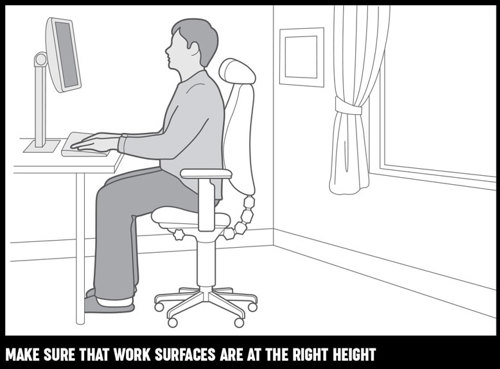
If you need more advice on workplace adjustments, you and your manager can arrange a workplace assessment. An occupational therapist or physiotherapist can do this.
An occupational therapist can advise you on changing the way you work and on equipment that may help you to do your job more easily.
If you haven't told your employer that you have RA, an occupational therapist can also give you advice about changes you could make without visiting your workplace.
4. Get a good night's sleep
If you’re not sleeping well, think about the reasons behind it. Is it pain and stiffness during the night? Or are you having trouble winding down?
If pain and stiffness during the night are affecting your sleep:
- Take some painkillers before bed.
- Have a warm bath or shower to help you relax.
- Check your mattress is supportive and comfortable. If you decide to buy a new one, you don’t have to go for the most expensive – try before you buy.
- Use fewer pillows if you have neck pain.
Rearrange pillows into a V-shape to support painful shoulders or try a specially shaped neck pillow. These are available from department stores. Although there’s no evidence that they help with the causes of pain, some people find they help to keep the neck in a comfortable position. - If your hands are painful, resting splints may help.
If you’re having difficulty winding down:
- Avoid eating a big meal late in the evening.
- Avoid drinking tea, coffee or alcohol for a couple of hours before bedtime.
- Try a hot, milky drink instead.
- Get into a bedtime routine. Try to go to bed at the same time every night.
- Do a few gentle stretching exercises, have a warm bath or shower and listen to some relaxing music. Take time for yourself.
- Make your bedroom a relaxing place with low lighting, relaxing colours and no clutter, computer or TV.
- Concentrate on your breathing and work through a relaxing technique.
Keeping fit and healthy
Keeping fit and healthy is an important part of looking after your joints. You can do this by exercising, eating a balanced diet and taking care of your body.
Exercise
Exercising helps to keep your muscles strong and your joints moving. You can even exercise without putting strain on your joints.
Joint protection and exercise work together. Joint protection reduces strain on your joint capsule and ligament, which can become slack if you have arthritis, and straining them can make this worse. Exercise strengthens the muscles around your joint so that they can help to support it.
Diet
Being overweight puts an extra burden on your weight-bearing joints (your back, hips, knees, ankles and feet) when they’re already damaged or under strain.
Because of the way your joints work, the pressure in your knee joints is 5–6 times your body weight when you walk. For this reason, it’s important to maintain a healthy weight. You can do this by taking regular exercise, for example swimming, which is particularly good for people with arthritis because the water supports your joints.
Eating a Mediterranean-style diet is good for providing all the nutrients and vitamins you need. This includes:
- lots of fruit and vegetables
- oily fish
- nuts and seeds
- olive oil.
Some people take dietary supplements to help protect their joints which can be found in some supermarkets and health food stores.
Generally speaking supplements are relatively well tolerated, but you should speak to your doctor about taking them because some can interfere with other medication, for example St John’s wort reduces the effectiveness of contraceptive pills.
If you decide to try any supplement, you should question what they’re doing for you, and base your decision to continue on whether you notice any improvement.
Foot care
Having painful feet can limit you getting out of the house for work, leisure, shopping and exercise. Good shoes help to protect your feet in the long term.
Ask to be referred to a podiatrist if you have RA and your feet are painful or starting to change shape.
Who else can help me to look after my joints?
You don't have to start using joint protection techniques on your own. Healthcare professionals, local groups, and friends and family can all help to provide support and encouragement.
Healthcare professionals
Healthcare professionals can help support people in adapting their lifestyle. This can include:
- rheumatology nurses
- occupational therapists
- physiotherapists.
Your occupational therapist can discuss the information in this section with you and suggest more ways you can reduce aches, pain and strain, which may help to slow down the development of joint deformities.
Independent Living Centres
Independent Living Centres (ILCs) are located in each capital city and provide information about assistive technology. See www.ilcaustralia.org.au or call the National ILC Infoline on 1300 885 886 to find your closest centre and more information. (Note, the Independent Living Centre is called LifeTec in QLD).
Friends and family
Learning about the things described here can help your family and carers to understand some of the problems you might face. Some people find it very helpful if their family or friends become involved as they practise some of the ideas mentioned in this section.
If they’re supportive, give you feedback on how you’re doing and help you to find solutions to problems, you may find you’re able to adopt the new movements or activities more quickly.
